The Glucosamine Supplement Market is estimated to be valued at USD 641.0 million in 2025 and is projected to reach USD 1024.4 million by 2035, registering a compound annual growth rate (CAGR) of 4.8% over the forecast period.
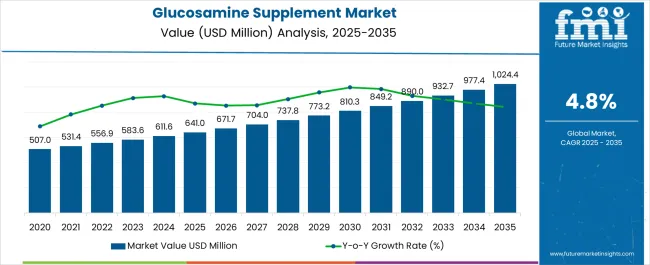
| Metric | Value |
|---|---|
| Glucosamine Supplement Market Estimated Value in (2025 E) | USD 641.0 million |
| Glucosamine Supplement Market Forecast Value in (2035 F) | USD 1024.4 million |
| Forecast CAGR (2025 to 2035) | 4.8% |
The glucosamine supplement market is expanding steadily as awareness around joint health, bone strength, and preventive nutrition rises among aging populations and health conscious consumers. Increasing prevalence of osteoarthritis and lifestyle related joint disorders has accelerated the need for effective nutraceutical solutions.
Capsules and functional ingredients like n acetyl glucosamine are being widely adopted due to their proven efficacy, convenient formats, and compatibility with dietary routines. Continuous advancements in formulation science, including enhanced bioavailability and plant based alternatives, are also strengthening demand.
Additionally, the integration of glucosamine in functional food and beverages is creating new growth avenues as consumers prefer preventive health products over pharmaceutical interventions. Regulatory approvals and recognition of glucosamine as a safe dietary supplement across multiple regions are reinforcing market growth, while the focus on personalized nutrition further enhances opportunities for targeted supplement formulations.
The market is segmented by Type, Product Type, and Application and region. By Type, the market is divided into Capsules, Soft-gels, Tablets, Caplets, Liquids, Powders, and Others. In terms of Product Type, the market is classified into n-acetyl glucosamine, Glucosamine hydrochloride, and Glucosamine sulfate. Based on Application, the market is segmented into Food and beverages, Dairy products, and Nutritional supplements. Regionally, the market is classified into North America, Latin America, Western Europe, Eastern Europe, Balkan & Baltic Countries, Russia & Belarus, Central Asia, East Asia, South Asia & Pacific, and the Middle East & Africa.
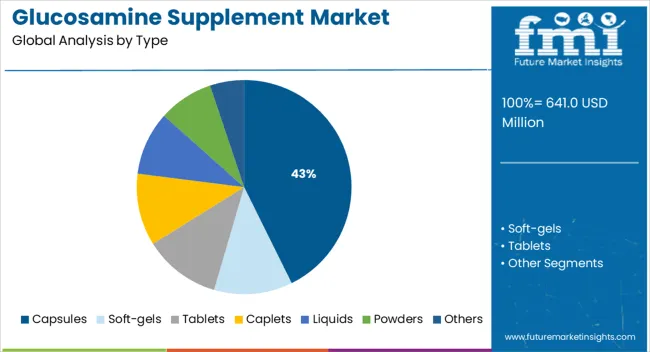
The capsules segment is projected to account for 42.70% of total revenue by 2025 within the type category, making it the most prominent format. This dominance is driven by consumer preference for standardized dosages, portability, and ease of consumption.
Capsules ensure better stability of glucosamine formulations, extended shelf life, and accurate intake which has strengthened their acceptance among patients and health conscious consumers. Their compatibility with vegetarian and vegan formulations has further enhanced adoption.
The ability of capsules to integrate multiple synergistic ingredients such as chondroitin and MSM also adds value to their therapeutic potential, reinforcing their leadership in the type category.
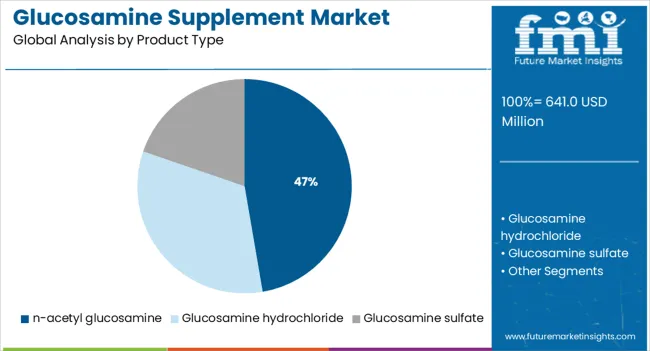
The n acetyl glucosamine segment is expected to represent 47.30% of market revenue by 2025 under the product type category, positioning it as the leading variant. Its dominance is attributed to superior solubility, bioavailability, and multifunctional health benefits that extend beyond joint support.
This product type is widely recognized for its role in promoting gut health, skin hydration, and immune modulation, which has expanded its applications in nutraceuticals and functional foods. Rising consumer demand for multifunctional ingredients that deliver both preventive and therapeutic outcomes has boosted adoption.
Continuous R and D investments aimed at enhancing clinical validation and safety have further established n acetyl glucosamine as the preferred product type in the glucosamine supplement market.

The food and beverages segment is projected to hold 44.80% of overall revenue by 2025 within the application category, making it the dominant sector. Growth in this segment is supported by consumer preference for functional foods that integrate health benefits into daily diets.
Glucosamine infused beverages, fortified foods, and dietary powders are being increasingly accepted as preventive solutions for joint health and mobility. The convenience of incorporating glucosamine into everyday consumption patterns has expanded its appeal across diverse demographics.
Moreover, the shift toward clean label, natural, and plant based formulations aligns with consumer values, driving higher adoption. The food and beverages application continues to set the pace for future growth due to its ability to merge health functionality with lifestyle convenience.
With a CAGR of 2.9% between 2020 and 2025, the global market for Glucosamine Supplements Market expanded from USD 505.9 Million to USD 567.2 Million.
Due to poor diet, a hectic lifestyle, and a rising demand for dietary fibers in functional food and beverage items, chronic diseases including diabetes, cancer, and obesity are becoming more common. This is one of the main factors driving the growth of the glucosamine supplement market. Another significant aspect that is anticipated to boost the growth of the worldwide glucosamine supplements market throughout the projected period is the growing use of glucosamine supplements in the pharmaceutical industry to treat various cardiovascular illnesses, diabetes, and blood pressure.
The development of the global market for glucosamine supplements throughout the forecast period will be influenced by additional variables, such as the branding of dietary supplements by significant manufacturers to preserve their dominance in specific regions.
With a high CAGR of 4.8% over the projected period, it is expected that the global Glucosamine Supplements Market would increase from USD 641 Million in 2025 to USD 1024.4 Million by 2035.
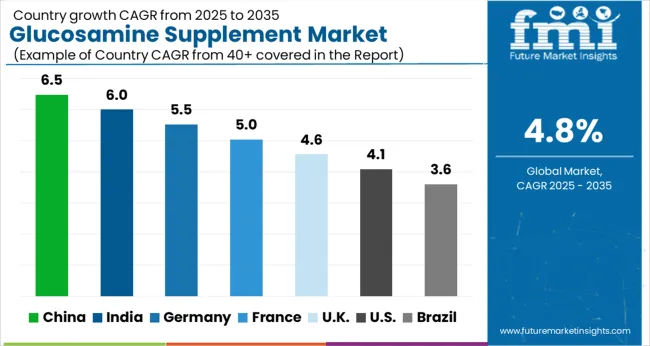
The Glucosamine Supplements market in North America is experiencing steady growth and development. The region has seen a significant increase in the demand for Glucosamine Supplements, largely due to its ability to address joint problems such as arthritis. The popularity of glucosamine supplements has grown significantly over the past decade, with more people turning to natural alternatives for health and wellness solutions.
In North America, the Glucosamine Supplements market is driven by factors such as growing awareness about the benefits of these products, increasing consumer expenditure on healthcare products and services, rising prevalence of joint-related disorders among aging populations and an expanding retail sector. Furthermore, new product launches from various manufacturers are also contributing to the growth of this market in this region.
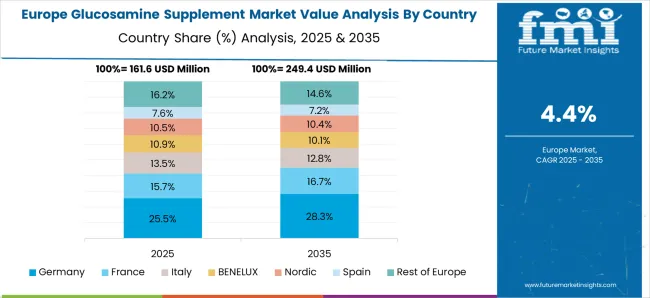
Europe is a key market for glucosamine supplements. The demand for natural remedies and dietary supplements has been on the rise in Europe, particularly in the United Kingdom, Germany, France and Spain. With increasing health awareness among Europeans, there has been a surge of interest in glucosamine as an effective alternative to traditional medication.
Glucosamine is used by many people with joint pain or arthritis to help reduce symptoms and improve mobility. It is available as an over-the-counter supplement in many European countries including France, Italy and Austria. The use of glucosamine supplements has grown significantly across Europe over the past decade due to rising consumer demand for natural remedies with fewer side effects than pharmaceutical medications.
The market for Glucosamine Supplements is expanding rapidly in the Asia Pacific region. The demand for these supplements, which are used to relieve pain caused by joint inflammation and other joint-related conditions, has increased steadily over the past few years. This is due to an increase in awareness about the health benefits of taking glucosamine supplements as well as a growing number of people suffering from joint-related conditions.
The Asia Pacific region is currently one of the largest markets for glucosamine supplements, with China and India leading in terms of sales volumes. Factors such as rising incomes, an increase in elderly population and greater access to healthcare are also contributing to this growth. Additionally, countries like Japan and South Korea have also seen a surge in popularity due to their aggressive marketing campaigns that promote these products.
The food and beverage industry is always looking for new ways to improve the health of their products. Glucosamine supplements are one of the latest innovations being used in this industry. Glucosamine is an amino sugar derived from glucose, which has been found to have potential health benefits due to its anti-inflammatory properties. It can be found in certain foods and beverages, such as seafood, chicken, pork and dairy products, as well as nutraceuticals (supplements).
Glucosamine supplements are commonly used by individuals who suffer from joint pain or arthritis related inflammation due to its reported ability to reduce swelling and tenderness. It is also being used in a variety of food products from snacks to energy drinks, providing consumers with added nutrition without additional calories or fat.
Glucosamine is known for its anti-inflammatory properties which help reduce joint pain and discomfort caused by arthritis or injury. Dairy cows are often under pressure due to their long periods of production which means they need extra support with joint health. Glucosamine provides this support by supporting the breakdown of cartilage tissue while providing nutrients that help build new cartilage cells.
Glucosamine supplements are used in dairy products to improve the health of cows and other animals. As an important dietary supplement, glucosamine helps to maintain healthy joints and bones in larger livestock, including cows. It can be found in a variety of dairy products, from cheese and yogurt to milk and cream.

The competitive landscape of the glucosamine supplements market is highly fragmented, with a large number of players operating at both the global and regional levels. Some of the major players in the market include GlaxoSmithKline, Pfizer Inc., Merck & Co., Inc., Sanofi, and Novartis AG. These players are focusing on strategic partnerships and collaborations, as well as product innovation and expansion in order to increase their market share.
Additionally, many smaller players also exist, such as Solgar, BioTech USA, Nature's Best, and others. The market is also witnessing an increasing number of private label and store brand products, which are typically less expensive than those of major brands. This competition is likely to continue to drive innovation and price competition in the market.
| Attribute | Details |
|---|---|
| Forecast Period | 2025 to 2035 |
| Historical Data Available for | 2020 to 2025 |
| Market Analysis | USD Million for Value and Units for Volume |
| Key Regions Covered | North America; Latin America; Europe; Asia Pacific; MEA |
| Key Countries Covered | Philippines, India, Malaysia, Thailand, USA, Germany, China, Japan, Denmark, Canada, Mexico, Poland, UK, Turkey, France, Italy, Spain, South Korea, Russia, Australia, Brazil, Argentina, South Africa |
| Key Segments Covered | Type, Product Type, Application, Region |
| Key Companies Profiled | GlaxoSmithKline; Pfizer Inc.; Merck & Co. Inc.; Sanofi; Novartis AG; Solgar; BioTech USA; Nature's Best; Mylan N.V.; Teva Pharmaceutical Industries Ltd. |
| Report Coverage | DROT Analysis, Market Forecast, Company Share Analysis, Market Dynamics and Challenges, Competitive Landscape and Strategic Growth Initiatives |
| Customization & Pricing | Available upon Request |
The global glucosamine supplement market is estimated to be valued at USD 641.0 million in 2025.
The market size for the glucosamine supplement market is projected to reach USD 1,024.4 million by 2035.
The glucosamine supplement market is expected to grow at a 4.8% CAGR between 2025 and 2035.
The key product types in glucosamine supplement market are capsules, soft-gels, tablets, caplets, liquids, powders and others.
In terms of product type, n-acetyl glucosamine segment to command 47.3% share in the glucosamine supplement market in 2025.






Our Research Products

The "Full Research Suite" delivers actionable market intel, deep dives on markets or technologies, so clients act faster, cut risk, and unlock growth.

The Leaderboard benchmarks and ranks top vendors, classifying them as Established Leaders, Leading Challengers, or Disruptors & Challengers.

Locates where complements amplify value and substitutes erode it, forecasting net impact by horizon

We deliver granular, decision-grade intel: market sizing, 5-year forecasts, pricing, adoption, usage, revenue, and operational KPIs—plus competitor tracking, regulation, and value chains—across 60 countries broadly.

Spot the shifts before they hit your P&L. We track inflection points, adoption curves, pricing moves, and ecosystem plays to show where demand is heading, why it is changing, and what to do next across high-growth markets and disruptive tech

Real-time reads of user behavior. We track shifting priorities, perceptions of today’s and next-gen services, and provider experience, then pace how fast tech moves from trial to adoption, blending buyer, consumer, and channel inputs with social signals (#WhySwitch, #UX).

Partner with our analyst team to build a custom report designed around your business priorities. From analysing market trends to assessing competitors or crafting bespoke datasets, we tailor insights to your needs.
Supplier Intelligence
Discovery & Profiling
Capacity & Footprint
Performance & Risk
Compliance & Governance
Commercial Readiness
Who Supplies Whom
Scorecards & Shortlists
Playbooks & Docs
Category Intelligence
Definition & Scope
Demand & Use Cases
Cost Drivers
Market Structure
Supply Chain Map
Trade & Policy
Operating Norms
Deliverables
Buyer Intelligence
Account Basics
Spend & Scope
Procurement Model
Vendor Requirements
Terms & Policies
Entry Strategy
Pain Points & Triggers
Outputs
Pricing Analysis
Benchmarks
Trends
Should-Cost
Indexation
Landed Cost
Commercial Terms
Deliverables
Brand Analysis
Positioning & Value Prop
Share & Presence
Customer Evidence
Go-to-Market
Digital & Reputation
Compliance & Trust
KPIs & Gaps
Outputs
Full Research Suite comprises of:
Market outlook & trends analysis
Interviews & case studies
Strategic recommendations
Vendor profiles & capabilities analysis
5-year forecasts
8 regions and 60+ country-level data splits
Market segment data splits
12 months of continuous data updates
DELIVERED AS:
PDF EXCEL ONLINE
Glucosamine Market
Chitosan Oligosaccharides and Glucosamine Market Analysis by Product Type, Source, Application, and Form Through 2035
Supplements And Nutrition Packaging Market
Supplementary Protectors Market
ACF Supplements Market Size and Share Forecast Outlook 2025 to 2035
Food Supplement Ingredients Market Size and Share Forecast Outlook 2025 to 2035
Viscosupplementation Market Analysis - Size, Share, and Forecast Outlook 2025 to 2035
PDRN Supplements Market Size and Share Forecast Outlook 2025 to 2035
Viscosupplementation Industry Analysis in Europe - Size, Share & Forecast 2025 to 2035
Feed Supplements Market Analysis - Size, Share & Forecast 2025 to 2035
Sleep Supplement Market Size and Share Forecast Outlook 2025 to 2035
Gummy Supplements Market Size and Share Forecast Outlook 2025 to 2035
Fiber Supplements Market Size and Share Forecast Outlook 2025 to 2035
Vegan Supplements Market Analysis by Ingredient Type, Form, Customer Orientation , Sales Channel and Health Concer Through 2035
Analysis and Growth Projections for Green Supplement Business
Andro Supplements Market
Custom Supplement Formulation Service Market Size and Share Forecast Outlook 2025 to 2035
Beauty Supplements Packaging Market Size and Share Forecast Outlook 2025 to 2035
Herbal Supplement Market Analysis - Size, Share, and Forecast Outlook 2025 to 2035
Beauty Supplement Market Analysis - Size, Share, and Forecast Outlook 2025 to 2035

Thank you!
You will receive an email from our Business Development Manager. Please be sure to check your SPAM/JUNK folder too.
Chat With
MaRIA